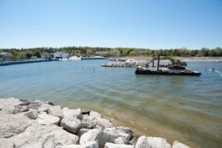Ask the Pro
- Share
- Tweet
- Pin
- Share
QUESTION from Sharon Peterson of Sturgeon Bay:
What determines the slope and rating of a golf course?

Pete Mogg
ANSWER from Pete Mogg, Head Golf Professional at Horseshoe Bay Golf Club:
Course rating and slope rating are determined for a golf course by a visit from the USGA (United States Golf Association) Course Rating Team.
The course rating team spends time at a club going over the course. While on the course the staff takes measurements of various things on the course. The USGA recommends that the staff members actually play the course at some time during their visit.
Based on the general information and measurements, the course rating and slope are then calculated. These calculations are certified by overseeing golf associations, and given to the club, which can then post the ratings on both the scorecard and any other general area.
Course ratings in the past were based solely on the length – the longer the course, the higher the rating. Currently different degrees of difficulty on the hole (for example, sand or water hazards, out of bounds areas, and distances) are being used to determine the ratings. The USGA does look at golf courses from both a scratch player’s perspective and a higher handicap golfer.
A scratch golfer definition is defined as a male golfer who hits his drive 250 yards and can reach a 450-yard par four in two shots: or a female golfer who can hit it 210 yards and can reach a 395-yard par four in two.
A high handicap player is defined as a male golfer with a handicap index of 16-23, who hits his drives 200 yards and can reach a 350-yard par four in two; and a female golfer with a handicap index of 21.5-26.5, who hits her drive 150-yards and can reach a 280-yard hole in two.
The USGA team also computes a “bogey rating,” something many golfers do not even know exists for each golf course. The bogey rating is similar to a course rating. It is an evaluation of how many strokes a bogey golfer will take to play the course rather than an evaluation of strokes needed by a scratch golfer. The bogey rating is the tool used to determinate the calculation that produces the slope rating. Slope is a number representing the relative difficulty of a course for bogey golfers compared to scratch golfers.
Effective playing length and obstacle stroke value are the determining factors in course rating and bogey rating. Effective playing length is not the actual length but how long the hole actually plays. A 450-yard hole will play shorter downhill, or longer if it is uphill. Altitude and firmness of the fairways are also factors.
Obstacle stroke value is a numerical rating of the difficulty presented by obstacles. The course is rated in 10 categories: topography, ease/difficulty of landing in the fairway, probability of hitting the green, difficulty of bunkers, probability of hitting into them, probability of hitting out of bounds, amount of water and trees on the course, speed and contour in the greens and the psychological effect of all of these areas.
In conclusion, the USGA rating team looks at all of these areas for both scratch and bogey golfers, and from every set of tees. Then the USGA follows their four formulas (male scratch player, female scratch player, male bogey player and female bogey player) After some adding, subtracting, multiplying and dividing, the ratings team produces its numbers.


